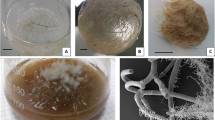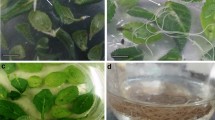Abstract
Rosmarinic acid, an important phenolic active compound, is one of the main active constituents of Agastache rugosa Kuntze and has astringent properties, antioxidant capacity, anti-inflammatory activity, antimutagenic ability, antimicrobial capacity, and antiviral properties. To investigate in vitro production of rosmarinic acid, we established a hairy root culture of A. rugosa by infecting leaf and stem explants with Agrobacterium rhizogenes R1000, and tested the growth and rosmarinic acid production of these cultures. Hairy roots were cultured in Murashige and Skoog liquid medium and maximum growth (14.1 g dry wt/l) was attained after 14 days of culture, at which time the content of rosmarinic acid was 116 mg/g dry wt. The present results demonstrate that hairy root culture of A. rugosa is a valuable alternative approach for the production of rosmarinic acid.


Similar content being viewed by others
References
Chen H, Chena F, Chiu FC, Lo CM (2001) The effect of yeast elicitor on the growth and secondary metabolism of hairy root cultures of Salvia miltiorrhiza. Enzyme Microb Technol 28:100–105
Giri A, Narasu MJ (2000) Transgenic hairy roots: recent trends and applications. Biotechnol Adv 18:1–22
Grzegorczyk I, Krolicka A, Wysokinska H (2006) Establishment of Salvia officinalis L. hairy root cultures for the production of rosmarinic acid. Z Naturforsch [C] 61:351–356
Guillon S, Tremouillaux-Guiller J, Pati PK, Rideau M, Gantet P (2006a) Harnessing the potential of hairy roots: dawn of a new era. Trends Biotechnol 24:403–409
Guillon S, Tremouillaux-Guiller J, Pati PK, Rideau M, Gantet P (2006b) Hairy root research: recent scenario and exciting prospects. Curr Opin Plant Biol 9:341–346
Hamill JD, Parr AJ, Rhodes MJC, Robins RJ, Walton NJ (1987) New routes to plant secondary products. Biotechnology 5:800–804
Hong JH, Choi JH, Oh SR, Lee HK, Park JH, Lee KY, Kim JJ, Jeong TS, Oh GT (2001) Inhibition of cytokine-induced vascular cell adhesion molecule-1 expression; possible mechanism for anti-atherogenic effect of Agastache rugosa. FEBS Lett 495:142–147
Kim HK, Oh SR, Lee HK, Huh H (2001a) Benzothiadiazole enhances the elicitation of rosmarinic acid production in a suspension culture of Agastache rugosa O. Kuntze. Biotechnol Lett 23:55–60
Kim TH, Shin JH, Baek HH, Lee HJ (2001b) Volatile flavour compounds in suspension culture of Agastache rugosa Kuntze (Korean mint). J Sci Food Agric 81:569–575
Li W, Koike K, Asada Y, Yoshikawa T, Nikaido T (2005) Rosmarinic acid production by Coleus forskohlii hairy root cultures. Plant Cell Tissue Organ Cult 80:151–155
Ly TN, Shimoyamada M, Yamauchi R (2006) Isolation and characterization of rosmarinic acid oligomers in Celastrus hindsii Benth leaves and their antioxidative activity. J Agric Food Chem 54:3786–3793
Murashige T, Skoog F (1962) A revised medium for rapid growth and bioassays with tobacco tissue cultures. Physiol Plant 15:473–497
Oh HM, Kang YJ, Kim SH, Lee YS, Park MK, Heo JM, Sun J, Kim HJ, Kang ES, Kim HJ, Seo HG, Lee JH, Yun-Choi HS, Chang KC (2005) Agastache rugosa leaf extract inhibits the iNOS expression in ROS 17/2.8 cells activated with TNF-alpha and IL-1beta. Arch Pharm Res 28:305–310
Parnham MJ, Kesselring K (1985) Rosmarinic acid. Drugs Future 10:756–757
Petersen M, Simmonds MSJ (2003) Rosmarinic acid. Phytochemistry 62:121–125
Shin S, Kang CA (2003) Antifungal activity of the essential oil of Agastache rugosa Kuntze and its synergism with ketoconazole. Lett Appl Microbiol 36:111–115
Signs M., Flores H (1990) The biosynthetic potential of plant roots. Bioessays 12:7–13
Tada H, Murakami Y, Omoto T, Shimomura K, Ishimaru K (1996) Rosmarinic acid and related phenolics in hairy root cultures of Ocimum basilicum. Phytochemistry 42:431–434
Acknowledgments
This study was supported by research funds from Chosun University, 2007.
Author information
Authors and Affiliations
Corresponding author
Rights and permissions
About this article
Cite this article
Lee, S.Y., Xu, H., Kim, Y.K. et al. Rosmarinic acid production in hairy root cultures of Agastache rugosa Kuntze. World J Microbiol Biotechnol 24, 969–972 (2008). https://doi.org/10.1007/s11274-007-9560-y
Received:
Accepted:
Published:
Issue Date:
DOI: https://doi.org/10.1007/s11274-007-9560-y




